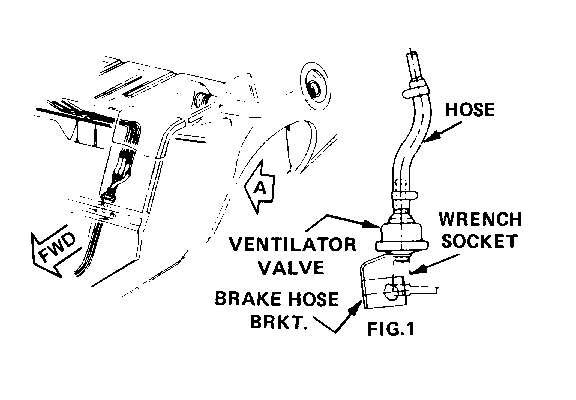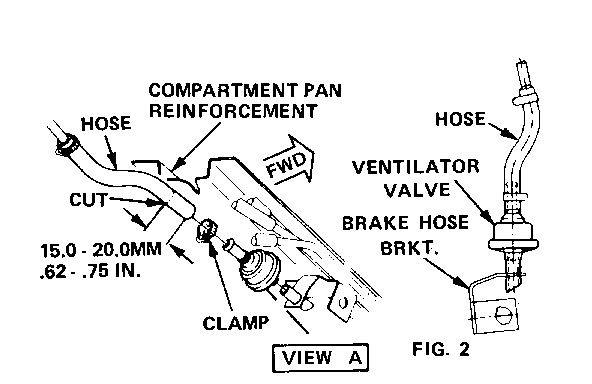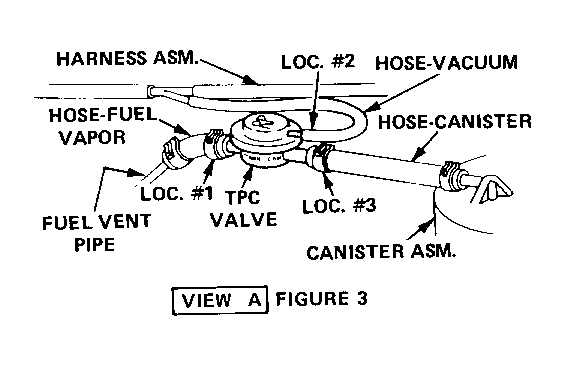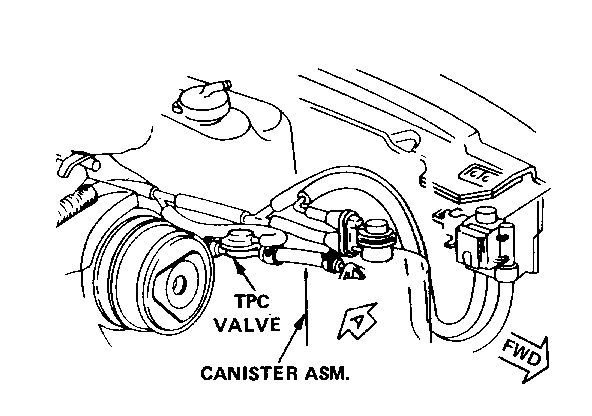CAMPAIGN: FUEL TANK VENTILATOR VALVE

Subject: PRODUCT SAFETY CAMPAIGN 82C19 FUEL TANK VALVE - 1982 CHEVROLET CAMARO MODELS EQUIPPED WITH RPO LU5 (5.0L V8) CROSS FIRE FUEL INJECTION ENGINE
The National Traffic and Motor Vehicle Safety Act, as amended, provides that each vehicle which is subject to a recall campaign of this type must be adequately repaired within a reasonable time after the owner has tendered it for repair. A failure to adequately repair within 60 days after tender of a vehicle is prima facie evidence of failure to repair within a reasonable time. If the condition is not adequately repaired within a reasonable time, the owner may be entitled to an identical or reasonably equivalent vehicle at no charge, or to a refund of the purchase price less a reasonable allowance for depreciation.
To avoid having to provide these burdensome solutions, every effort must be made to promptly schedule an appointment with each owner and to repair their vehicles as soon as possible. As you will see in reading the attached copy of the letter which is being sent to owners, the owners are being instructed to contact the nearest Chevrolet Zone office if their dealer does not remedy the condition within five days of the agreed service date. If the condition is not remedied within a reasonable time, the owners are instructed how to contact the National Highway Traffic Safety Administration.
DEFECT INVOLVED
General Motors has determined that a defect which relates to motor vehicle safety exists on 1982 Chevrolet Camaros equipped with RPO LU5 (5.OL V8) Cross Fire Fuel Injection engines. The fuel tank ventilator valve in the fuel system of these vehicles may produce a loud and persistent "whistle" during the venting of the tank. If the fuel filler cap is removed while this con- dition exists and the tank is over 3/4 full, gasoline may be forced out of the filler neck and onto any person standing nearby. Also, should this occur, the possibility of a fire exists, which could cause burn injuries.
VEHICLES INVOLVED
Involved are all 1982 Chevrolet Camaro models equipped with RPO LU5 (5.OL V8) Cross Fire Fuel Injection engines built within the following breakpoints:
Beginning Up To And Plant VIN Including -------- -------- --------- Van Nuys CL100001 CL188853 Norwood CN100001 CN149018
Involved vehicles have been identified by Vehicle Identification Number Computer Listings. Computer listings contain the complete Vehicle Identification Number, owner name and address data, and are furnished to the involved dealers with the campaign bulletin. Owner name and address data furnished will enable dealers to follow-up with owners involved in this campaign.
These listings may contain owner names and addresses obtained from State Motor Vehicle Registration Records. The use of such motor vehicle registration data for any other purpose is a violation of law in several states. Accordingly, you are urged to limit the use of this listing to the follow-up necessary to complete this campaign. Any dealer not receiving a computer listing with the campaign bulletin was not shipped any involved vehicles.
OWNER NOTIFICATION
Owners will be notified of this campaign on their vehicles by Chevrolet Motor Division.
DEALER CAMPAIGN RESPONSIBILITY
Dealers are to service all vehicles subject to this campaign, regardless of mileage, age of vehicle, or ownership, from this time forward.
Whenever a vehicle subject to this campaign is taken into your new or used vehicle inventory or it is in your dealership for service in the future, you should take the steps necessary to be sure the campaign correction has been made.
SERVICE PROCEDURE
FUEL TANK VENTILATOR VALVE REPLACEMENT Location: Left Front of Fuel Tank
1. Raise vehicle on hoist.
2. Remove fuel tank ventilator valve (white in color) from brake hose bracket by compressing plastic locking prongs and pushing valve out of bracket. (Suggest compressing with a 7/16 in. or 12mm socket.) Figure 1.
3. Loosen hose clamp and remove fuel tank ventilator valve from hose and discard the valve.
4. Shorten the existing hose by cutting off 15-20mm (5/8 to 3/4 in.).
5. Install square end of new fuel tank ventilator valve hose to prong end of new fuel tank ventilator valve (Figure 2).
6. Install new fuel tank ventilator valve to the shortened existing fuel tank vent hose and tighten clamp. Torque 1.4-1.7 N.m (15 in. lbs.).
7. Insert angle end of new fuel tank ventilator valve hose into hole in brake hose bracket as shown in Figure 2. Be sure to pull hose through bracket at least 13mm (1/2 in.).
8. Lower vehicle.
FUEL TANK PRESSURE CONTROL VALVE (TPCV) REPLACEMENT Location: Left Front Corner of Engine Compartment
1. Open hood.
2. Pinch and slide clamp back on hose at location #1 (View A), (Figure 3) tank end of tank pressure control (TPC) valve.
3. Pull TPC valve from hose.
4. Remove vacuum supply hose from TPC valve location #2 (View A), (Figure 3).
5. Pinch and slide clamp forward on canister hose location #3 (View A), (Figure 3) .
6. Pull TPC valve from canister hose and discard valve.
7. Install canister hose to canister end of new TPC valve and reposition clamp at location #3 (View A), (Figure 3).
8. Install vacuum supply hose to new TPC valve at location #2 (View A), (Figure 3) .
9. Install tank end of TPC valve to fuel tank vent pipe hose at location #1 (View A), (Figure 3) reposition clamp.
This valve is directional and must be oriented correctly. "TANK" and "CAN" are printed adjacent to the respective nipples. "TANK" toward the fuel vent pipe and "CAN" toward the center.
10. Install campaign label according to instructions contained in this bulletin.
11. Close hood.
PARTS INFORMATION
Fuel System Kit(s) (part number 14065753) required to complete this modification are to be obtained by the dealer from Ware- house Distribution Division of General Motors (WDDGM). Kit consists of a new fuel tank ventilator valve, "tank" pressure control valve, fuel tank vent valve hose and instruction sheet.
The removed parts are to be retained for disposition by zone personnel.
CLAIM INFORMATION
Submit a Product Claim with the information indicated below:
Parts Failed Parts Failure Labor Labor *Other Count Part No. Allowance Code Operation Hours Hours ----- -------- --------- ---- --------- ----- ----- 1 14065753 00 V1350 .3 .1
Description: Install "Fuel System Kit", P/N 14065753, according to the instructions outlined in this bulletin.
*Campaign Administrative Allowance
Dealers will automatically receive the correct labor and material allowance plus 30% based on the labor operation performed. Refer to the Chevrolet Claims Processing Manual for details on Product Campaign claim submission.
CAMPAIGN IDENTIFICATION LABEL
Each vehicle modified in accordance with the instructions outlined in this Product Campaign Bulletin will require a "Campaign Identification Label". Each label provides a space to include the five digit dealer code of the dealer performing the campaign service. This information may be inserted with a typewriter or ballpoint pen.
Each "Campaign Identification Label" is to be located on the radiator core support in an area which will be visible when the vehicle is brought in for periodic servicing by the owner.
Apply "Campaign Identification Label" only on a clean dry surface.
ADMINISTRATIVE PROCEDURE
REFER TO THE CURRENT CHEVROLET SERVICE POLICIES AND PROCEDURES MANUAL AND CLAIMS PROCESSING MANUAL FOR CAMPAIGN HANDLING AND ADMINISTRATIVE PROCEDURES.




General Motors bulletins are intended for use by professional technicians, not a "do-it-yourselfer". They are written to inform those technicians of conditions that may occur on some vehicles, or to provide information that could assist in the proper service of a vehicle. Properly trained technicians have the equipment, tools, safety instructions and know-how to do a job properly and safely. If a condition is described, do not assume that the bulletin applies to your vehicle, or that your vehicle will have that condition. See a General Motors dealer servicing your brand of General Motors vehicle for information on whether your vehicle may benefit from the information.
